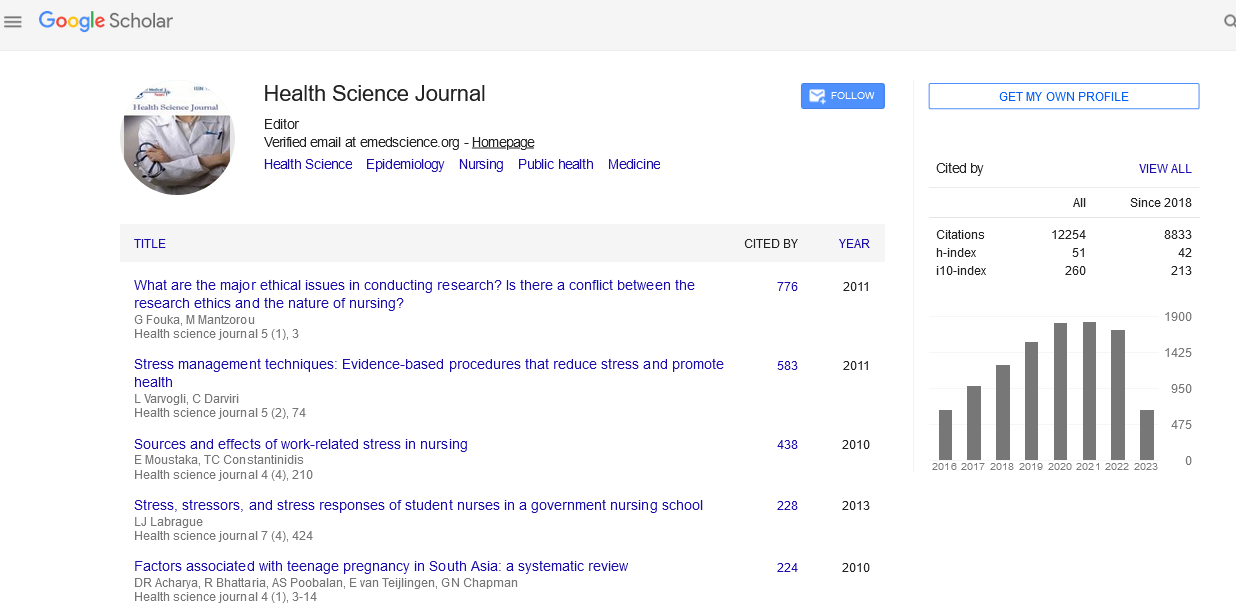Editorial - (2024) Volume 18, Issue 12
Effects of Air Quality on Cognitive Decline in Older Adults
Huiying Lan*
Department of Health & Medicine, Northwestern University, USA
*Correspondence:
Huiying Lan, Department of Health & Medicine, Northwestern University,
USA,
Email:
Received: 01-Dec-2024, Manuscript No. Iphsj-24-15445;
Editor assigned: 04-Dec-2024, Pre QC No. Iphsj-24-15445 (PQ);
Reviewed: 26-Dec-2024, QC No. Iphsj-24-15445;
Revised: 28-Dec-2024, Manuscript No. Iphsj-24-15445 (R);
Published:
31-Dec-2024, DOI: 10.36648/1791-809X.18.12.1206
Abstract
Recent studies have highlighted the potential link between air quality and cognitive decline in older adults. As air pollution levels rise globally, concerns about its effects on human health, particularly brain health, have become more pressing. Cognitive decline, including conditions such as dementia and Alzheimer's disease, is a major concern for aging populations. This article reviews the current literature on the effects of air quality on cognitive function in older adults, focusing on how exposure to pollutants such as particulate matter (PM), nitrogen dioxide (NO2), and sulfur dioxide (SO2) may contribute to neurological deterioration. The evidence suggests that long-term exposure to poor air quality accelerates cognitive decline and may increase the risk of developing neurodegenerative diseases. This article also discusses potential mechanisms, risk factors, and the need for policy interventions to mitigate exposure to air pollution in older populations.
Introduction
The global aging population is increasingly at risk of cognitive decline and neurodegenerative diseases, such as Alzheimer's disease and other forms of dementia. With the rising prevalence of these conditions, researchers are increasingly exploring environmental factors that may accelerate cognitive decline. Air pollution, particularly in urban areas with high levels of particulate matter (PM2.5), nitrogen dioxide (NO2), and sulfur dioxide (SO2), has emerged as a potential contributor to the deterioration of cognitive function in older adults [1]. While the effects of air quality on respiratory and cardiovascular health have been well-documented, its impact on brain health is an area of growing concern. This article explores the relationship between exposure to air pollution and cognitive decline in older adults. It examines the types of pollutants most associated with cognitive impairments, possible mechanisms behind this association, and the broader implications for public health.
Air Pollution and Cognitive Decline in Older Adults
Cognitive decline in older adults encompasses a wide range of symptoms, from mild memory lapses to severe dementia. Numerous studies have shown that exposure to poor air quality can accelerate this decline. In particular, long-term exposure to particulate matter (PM2.5) has been strongly linked to increased risks of cognitive decline. A study conducted by Power et al. (2018) found that exposure to high levels of PM2.5 was associated with a more rapid decline in cognitive function in adults aged 65 and older [2]. Similarly, a meta-analysis by Van der Weijden et al. (2020) showed a significant relationship between long-term exposure to air pollutants and the onset of cognitive impairment in older adults [3].
Mechanisms of Air Pollution's Impact on the Brain
The exact mechanisms through which air pollution contributes to cognitive decline are still being investigated. However, there are several proposed pathways. One of the most common theories is that inhaled particulate matter and gases from air pollution can enter the bloodstream through the respiratory system and cause systemic inflammation. This inflammation may then extend to the brain, particularly the hippocampus and frontal cortex, areas of the brain involved in memory, decision-making, and learning. In addition to direct inflammation, air pollution has been linked to oxidative stress and neurodegeneration. Pollutants such as nitrogen dioxide (NO2) and ozone can lead to the production of free radicals, which damage brain cells and contribute to neuroinflammation. Studies have shown that individuals living in areas with high air pollution levels exhibit increased markers of oxidative stress in their brains [4]. Research by Calderón-Garcidueñas et al. (2015) suggests that fine particulate matter can cross the blood-brain barrier and deposit in brain tissue, exacerbating cognitive deficits over time [5]. Additionally, animal studies have demonstrated that long-term exposure to air pollution leads to structural changes in the brain, including a reduction in the volume of the hippocampus, which plays a critical role in memory formation and retention [6].
Key Pollutants Linked to Cognitive Decline
- Particulate Matter (PM2.5): Particulate matter (PM), particularly PM2.5, which consists of particles less than 2.5 micrometers in diameter, is among the most harmful pollutants for human health. These tiny particles can penetrate deep into the lungs and enter the bloodstream, where they are transported throughout the body, including the brain. Studies have consistently shown that exposure to PM2.5 is associated with both cognitive decline and an increased risk of developing neurodegenerative diseases. A study by Adams et al. (2019) found that individuals living in regions with high PM2.5 concentrations had significantly lower cognitive scores and a higher incidence of dementia [7].
- Nitrogen Dioxide (NO2): Nitrogen dioxide (NO2) is another key air pollutant that has been linked to cognitive decline. NO2 is a major component of urban air pollution, especially in areas with heavy traffic. Prolonged exposure to NO2 has been associated with impairments in cognitive performance, particularly in older adults. A study by Weuve et al. (2012) found that higher NO2 exposure was linked to accelerated cognitive decline in older women, especially those with pre-existing health conditions such as hypertension.
- Ozone (O3): Ozone (O3), another component of air pollution, is also associated with cognitive impairments. Ozone exposure can lead to oxidative damage in the brain, contributing to cognitive deficits and neuronal injury. Research by Wu et al. (2015) found that long-term exposure to ozone was linked to both decreased cognitive function and increased incidence of dementia in older adults.
Risk Factors and Vulnerabilities
While air pollution is a significant risk factor for cognitive decline, certain populations are more vulnerable to its effects. Older adults, especially those with pre-existing conditions such as hypertension, diabetes, or cardiovascular disease, are at higher risk for the adverse effects of air pollution on brain health. The elderly often have compromised immune systems and reduced capacity for detoxification, making them more susceptible to the toxic effects of pollutants. Socioeconomic factors also play a critical role. People living in lower-income neighborhoods are often exposed to higher levels of air pollution due to proximity to industrial sites, highways, and other pollution sources. Furthermore, individuals with lower socioeconomic status may have less access to healthcare and fewer resources to mitigate the effects of air pollution, making them more vulnerable to cognitive decline. Another significant risk factor is genetic predisposition. Individuals with a family history of dementia or Alzheimer's disease may experience a more pronounced decline in cognitive function when exposed to poor air quality. Genetic markers related to neurodegenerative diseases, such as the APOE ε4 allele, may interact with environmental factors like air pollution to increase the likelihood of cognitive decline.
Public Health Implications and Policy Recommendations
Given the growing evidence of the link between air pollution and cognitive decline, public health interventions are needed to protect vulnerable populations, particularly older adults, from the harmful effects of poor air quality. Policymakers should prioritize reducing air pollution through stricter regulations on emissions from vehicles and industrial activities. In addition, efforts should be made to improve urban planning by creating green spaces and promoting cleaner public transportation options to reduce exposure to air pollutants. Health professionals can play a role by educating older adults about the risks of air pollution and encouraging them to take preventive measures, such as avoiding outdoor activities during times of high pollution and using air purifiers at home. Public health campaigns should also focus on reducing smoking and promoting a healthy diet and physical activity, which can help mitigate the effects of air pollution on cognitive health. Finally, more research is needed to fully understand the mechanisms through which air pollution contributes to cognitive decline and neurodegenerative diseases. Longitudinal studies that track air pollution exposure and cognitive function over time are essential to developing more effective prevention strategies.
Conclusion
The link between air quality and cognitive decline in older adults is becoming increasingly evident. Exposure to air pollutants such as PM2.5, NO2, and ozone accelerates cognitive impairment and increases the risk of developing neurodegenerative diseases. Although the exact mechanisms are still being explored, the evidence points to systemic inflammation, oxidative stress, and neuronal damage as key pathways through which air pollution impacts brain health. Older adults, particularly those with pre-existing health conditions, are particularly vulnerable to these effects. Addressing air pollution through policy changes, public health initiatives, and increased awareness is crucial to mitigating its effects on cognitive decline in aging populations.
References
- Wang J, Sun D, Huang L, Wang S, Jin Y (2021) Targeting reactive oxygen species capacity of tumor cells with repurposed drug as an anticancer therapy. Oxid Med Cell Longev 2021: 8532940.
Indexed at, Google Scholar, Crossref
- Bhattacharya B, Mukherjee S (2015) Cancer therapy using antibiotics. J. Cancer Ther 6: 849–858.
Indexed at, Google Scholar, Crossref
- Saintilnord WN, Fondufe-Mittendorf Y (2021) Arsenic-induced epigenetic changes in cancer development. Semin Cancer Biol 76:195–205.
Indexed at, Google Scholar, Crossref
- Ozturk M, Metin M, Altay V, Bhat RA, Ejaz M, et al. (2022) Arsenic and human health: Genotoxicity, epigenomic effects, and cancer signaling. Biol Trace Elem Res 200: 988–1001.
Indexed at, Google Scholar, Crossref
- Reichard JF, Puga A (2010) Effects of arsenic exposure on DNA methylation and epigenetic gene regulation. Epigenomics 2: 87–104.
Indexed at, Google Scholar, Crossref
- Yan S, Wu F, Zhou S, Yang J, Tang X, et al. (2021) Zinc oxide nanoparticles alleviate the arsenic toxicity and decrease the accumulation of arsenic in rice (Oryza sativa L.). BMC Plant Biol 21: 150.
Indexed at, Google Scholar, Cross Ref
- Deavall DG, Martin EA, Horner JM, Roberts R (2016) Drug metabolism and oxidative stress: Cellular mechanism and new therapeutic Insights. Biochem Anal Biochem 5: 1000255.
Indexed at, Google Scholar, Crossref
Citation: Lan H (2024) Effects of Air Quality on Cognitive Decline in Older Adults. Health Sci J. Vol. 18 No. 12: 1206.





